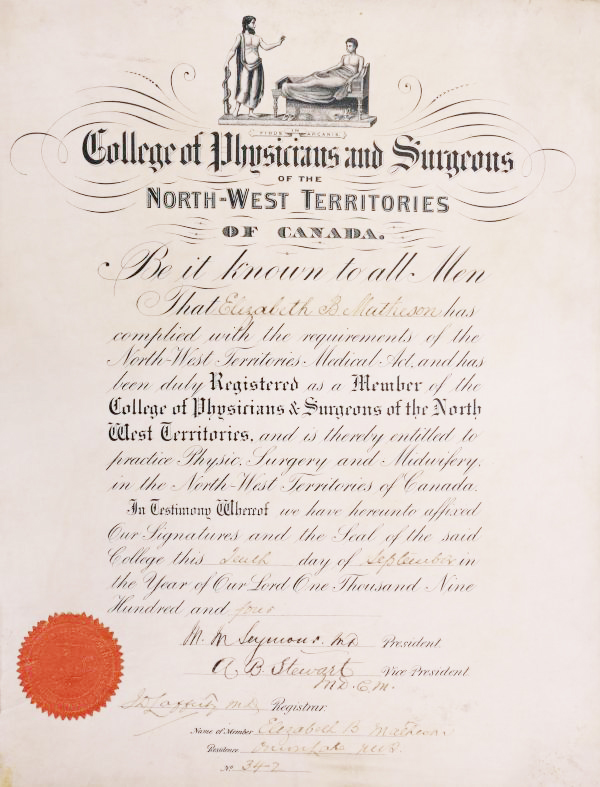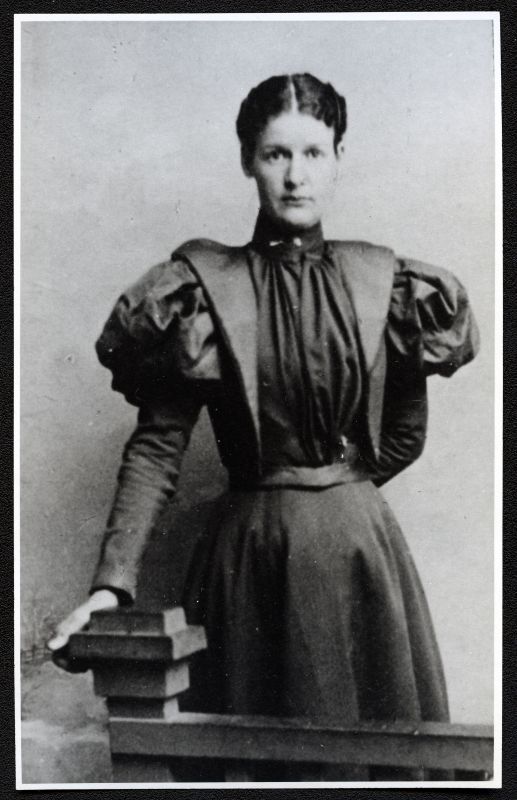It is an unfortunate fact that most historical records reflect the lives and impact of men. Seldom are the women’s contributions properly documented. So, when I was recently researching the background of the Onion Lake student residence, I was pleased to come across some excellent information regarding Elizabeth Scott Matheson, Saskatchewan’s first woman doctor. Although much of her life was lived outside Saskatchewan, and it is a bit of a stretch to consider Onion Lake as part of the area included in the Prince Albert Historical Society, I felt inclined to write about Mrs. Matheson.
Born to James and Elizabeth (Beckett) Scott in 1866 near Campellford, Canada West (now Ontario), Bessie (as she was known to her husband) began her education at age four at the Burnbrae school, at which school she continued until the family moved to take up a homestead at Morris, Manitoba, in 1878. Elizabeth continued her education, and later in Winnipeg where she completed high school and then trained at the normal school, becoming a school teacher at age seventeen.
A few years later, Elizabeth’s brother, Tom, encouraged her to return to Ontario, and arranged for her to take a position with Marchmount Homes in Belleville, a home where orphaned boys and girls from Great Britain were received and learned the rudiments of either farming or housework, dependent upon their sex. It was the director of the home, a Miss Bilbrough, who encouraged Elizabeth to enter the Women’s Medical College at Queen’s University in Kingston, Ontario. Miss Bilbrough even agreed to assist in meeting what expenses that Elizabeth could not afford herself.
It was during this year at Queen’s that Elizabeth joined the Student Volunteer Movement for Foreign Missions, after hearing a talk given by John Raleigh Mott on his tour of eastern universities. This led to an interview with the Presbyterian Missions Board of Toronto which had missions in central India. As a result, Elizabeth sailed in November 1888, arriving in Bombay, India, on New Year’s Day 1889. She had signed a seven-year teaching position but, in her second year she as often fevered, and had little energy. It appeared that she had contracted malaria, possibly while sailing through the Red Sea. Although Elizabeth felt that she could overcome the illness, the doctor disagreed, and she was returned to Canada in 1891.
After her return home, Elizabeth was encouraged to visit her sister in Vancouver, British Columbia. It was while she was in that city that she once again encountered John Matheson. Much appeared to have changed in Matheson’s life since their last meeting, which had occurred at a party in Manitoba when Elizabeth was nineteen years old. They had subsequently written to one another, the letters growing more and more infrequent as he openly wrote of his love for her and she tried to dampen his affection. Elizabeth felt that the difference in their lifestyles, as well as the distance between them, could never result in a relationship ever blossoming.
However, there was a major difference in their age (he was eighteen years older than her), and his lifestyle had always been rather “rough and ready”. Elizabeth’s sister and her husband were not impressed with the thought of Elizabeth establishing a romantic relationship with him, but Elizabeth appeared to see a much different side to him now than when she had first met him. He had, in fact, adopted a Christian lifestyle, and was interested in becoming a missionary.
So it was that John Matheson and Elizabeth Scott married at the Presbyterian manse on December 8th, 1891, with none of their family in attendance. Shortly thereafter, they began looking for opportunities in the field of mission work.
Initially, since Elizabeth had been attached to a Presbyterian mission, they applied to that denomination for whatever posting might be available. The Presbyterians decided that Matheson’s personal history was unsuitable for a position with them, and denied him right off. An application to the Methodist church was given consideration, but nothing was immediately offered. As a result of Matheson’s family connections with an Anglican branch of the family (their mother, a Pritchard, had a very strong family connection, as did Matheson’s brother Edward, who was the first graduate of Emmanuel College in Prince Albert), Bishop Pinkham, second bishop of the Diocese of Saskatchewan and the first bishop of the Diocese of Calgary, decided to appoint Matheson to the Anglican mission at Onion Lake.
The Mathesons left New Westminster in May, 1892, and travelled as far as Winnipeg to visit with his family. They then took the train back to Saskatoon, a community of “no more than a half-a-dozen houses that were either stores or stopping-places for freighters and stage-coach drivers and such travellers as themselves”. Aside from the flea-infested bedroom they were to stay in that night, the only lasting memory they had of the community was walking across the railway trestle and back again. Matheson had been one of the individuals who had, in his earlier years, been involved in the construction of that bridge.
Eventually, after travelling to the Battlefords, where they met and stayed with John’s brother Edward and his wife, they arrived at Onion Lake in August. The mission house and the church both required considerable repair, and the Mathesons set to work making both buildings far more solid prior to the winter months. Also, as the snow did not arrive until November of that year, they were able to prepare the garden for planting in the spring, and to repair the henhouse.

Attempts to encourage the local First Nations children to attend school were less than successful, with attendance each day amounting to two or three children, and not the same two or three each day. Elizabeth thought back to her time teaching in Bombay, and decided that the best approach would be to allow the children to live in the Matheson’s home, and to teach them right in the house. This was so successful that, by the end of the school year, there were almost 80 students living in the quickly constructed dormitories. Even the school inspector was impressed with the accommodations provided, and with the curriculum which was being taught.
Things were proceeding well for the Mathesons. The school was successful, they were accepted by most of the First Nations communities of the area, and their own family was growing. Bishop Pinkham had visited several times, and had been well satisfied with their work. Plans were made for him to meet with John Matheson at Duck Lake in 1894 to arrange for his ordination as a deacon of the Anglican church.
It was in 1894 that Elizabeth began to regret that she had not completed her medical training. Some deaths in the community, the spread of tuberculosis, and a request for an amputation of a man’s foot which she could not in all conscience undertake, resulted in the determination of the two of them that she needed to return and complete her medical degree. In 1895, she was enrolled in the Manitoba Medical College. During her term there, she delivered her third baby, a third daughter.
At the end of the term, she transferred to Trinity Medical College in Toronto, where she completed her training in 1898. She then successfully passed all of her exams, and returned to Onion Lake where her husband had built a three-storey hospital building complete with a surgical room.
Although the Northwest Territories College of Physicians and Surgeons were unwilling to grant Dr. Matheson a license (possibly because she refused to travel to Calgary to complete the necessary interview), she was designated as the district doctor by the government. Many believed that this came about due to the treatment she provided during the 1901 smallpox outbreak. Elizabeth was finally going to be paid for her work, at the rate of $300 a year.
After returning to the Manitoba Medical College in 1903 and completing another year of studies, she received a second medical degree. Even so, it took her husband’s intervention before the College of Physicians and Surgeons would grant Dr. Matheson a licence.
The Mathesons continued working at the Onion Lake mission until the death of the Reverend John Matheson in 1916. As his health declined, his wife took over his duties as principal of the school, adding that responsibility to her duties as a doctor. She remained in the community until 1918, when she relocated to Winnipeg, Manitoba, where she assumed the role of assistant medical officer for the Winnipeg public school system, a job she held until her retirement in 1941.
Dr. Matheson died in San Antonio, Texas, at the home of her daughter on January 15th, 1958. She was buried at Onion Lake.
fgpayton@sasktel.net


